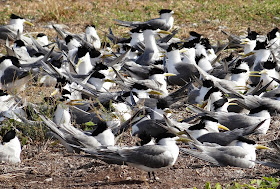 |
| Lady Elliot Island |
We have returned from a wonderful five days on Lady Elliot Island, the southern-most island of the Great Barrier Reef, seen here from the air as we arrived. We drove to Hervey Bay for the short flight to the island, stopping at Bundaberg en route.
 |
| Black Noddy with chick |
What strikes the visitor to Lady Elliot more than anything upon arrival is the abundance of birdlife. An estimated 100,000 seabirds nest on the island; we were there at the height of the nesting season. About 70 per cent of the seabirds are Black (White-capped) Noddies, which nest in trees across the island, including throughout the resort grounds.
 |
| Black Noddy & Me |
Like most other seabirds on the island, the Black Noddies are oblivious to the presence of human interlopers. They seemed to be constantly busying themselves, adding material to their flimsy nests, and keeping up the activity until well after sunset.
 |
| Black Noddy |
 |
| Common Noddy with chick |
Common or Brown Noddies were nesting on the island in smaller numbers, mostly at both ends of the airport runway. Unlike the Black Noddy, the Common Noddy nests on the ground. Both noddies had chicks in various stages of development - Black Noddy chicks are dark while Common Noddy chicks are pale.
 |
| Common Noddy |
 |
| Common Noddy (left) & Black Noddy (right) |
Sometimes the two noddy species could be seen together, allowing good comparisons. Two or three (sometimes more) planes land on the island daily, and some bird collisions are inevitable; this Common Noddy below was a victim during our stay.
 |
| Plane arriving on Lady Elliot |
 |
| Common Noddy plane strike victim |
 |
| Bridled Tern |
Bridled Tern was also numerous, nesting throughout the island and, like the Black Noddy, it was common around the resort grounds.
Many Bridled Terns were sitting on eggs on nests which were little more than slight scrapes in the ground, or small niches among the coral. Others had chicks resembling balls of fluff. Early morning was the best time to watch the youngsters being fed tiny fish or squid by their parents.
 |
| Bridled Tern |
The Bridled Terns nested everywhere and anywhere. It was a challenge not to step on them at times while wandering around the resort, especially at night.
 |
| Sooty Tern |
Sooty Terns were in much small numbers - about 20 birds were concentrated in one short stretch of beach, with several pairs sitting on eggs.
 |
| Sooty Tern |
 |
| Bridled Tern (above) & Sooty (below) Tern |
Bridled Terns and Sooty Terns were nesting side-by-side.
 |
| Roseate Tern |
About 400 Roseate Terns were nesting on the island, with most pairs attending well-developed chicks.
 |
| Roseate Tern |
Most Roseate Terns were in breeding plumage but the odd bird was in eclipse plumage.
 |
| Black-naped Tern |
Black-naped Terns were present in small numbers - about 30 or 40 birds were concentrated in a small section of beach.
 |
| Black-naped Tern (left) and Roseate Tern (right) |
Black-naped and Roseate Terns were nesting side-by-side in one spot.
 |
| Crested Tern |
Several hundred Crested Terns were nesting beside the airstrip.
 |
| Crested Tern (rear) & Lesser Crested Tern (front) |
Among the Crested Terns on the beach was a single Lesser Crested Tern.
 |
| Lady Elliot Island beach |
The stretch of beach where the Roseate and Black-naped Terns were nesting.
 |
| Our hut on the island |
The island has varying standards of accommodation depending on price. We elected to stay in the cheaper "eco-hut" but it was comfortable and adequate for our purposes, with sea views and birds constantly about the hut. We had Bridled Terns nesting by the hut wall and Wedge-tailed Shearwaters nesting behind the hut (more birds in the next post).























Great post and photos of a wonderful birding destination Greg. Hope to get there next year on our return journey.
ReplyDeleteIt seems like a great place for birders to visit at this time of the year.
ReplyDeleteGreat photos and information Greg - that's a place I definitely hope to see someday! My only experience with any of these species was trying to rescue a beautiful Sooty Tern after ex-TC Oswald earlier this year. It would be lovely to see them thriving where they belong!
ReplyDeleteJust repeating what everyone above has. Great photos and information. I'd love to visit and you couldn't ask for a better spot for the location of the eco hut.
ReplyDeleteOh my! Birding heaven!
ReplyDeleteyes agreed with everyone else - the photos are amazing. The noddy's are beautiful and your photos have captured all of the birds and their young so well! I don't know how you can manage to tell the different tern's apart!
ReplyDeleteA belated thanks everyone
ReplyDelete